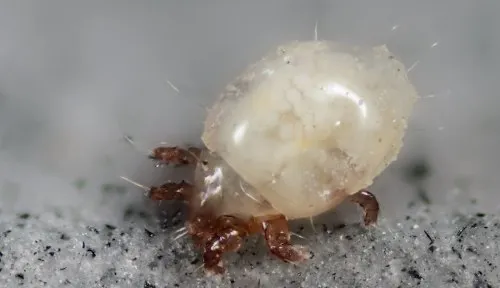In today’s article we are going to learn how to identify the white bugs in the soil of our plants. We will also see if they are good or not and how we can eliminate the harmful white bugs.
White bugs in the plant soil
Have you ever seen white bugs in your garden or potting soil, do they have wings, are they so small that you can’t see them or do they look like little worms?
I remind you that not all the bugs we see on our plants are harmful. There are predatory insects or parasitoids of other insects that can help us to put an end to pests in the garden.
Don’t worry, together we will find out who they are in each case.
White bugs in the potting soil: Springtails
I can already tell you that most of the times you see small white bugs in the soil, they will be springtails. Springtails are arthropods but are not considered insects. They belong to an order called “Collembola”. These bugs are present in all parts of the world and are probably one of the most numerous animals on the planet.

What are springtails?
Springtails can be of different colors: white, black, brown, etc. However, the ones we usually find in our potting soil are usually white. They are also very small.
The funniest thing about these little white bugs in the soil is that when they are attacked by a predator, they jump! Yes, they can jump up to 15 cm, it’s amazing! They do it thanks to an appendix they have on their body.

Are springtails bad?
This is one of the most common questions related to springtails. The answer is: in general NO. There are some exceptions, for example, Protaphorura armata, which attacks sugar beet crops.
In most cases they can be good for our soils. They are decomposers of plant and animal remains and can attack some species of nematodes.
In addition, some people cultivate springtails for use as food for small amphibians, other insects (e.g. mantids) or aquatic animals.
White millipedes in soil
Other white bugs in the soil, a little bigger than the springtails that we can find in the soil, can be millipedes. In this case, one in particular is called Scutigerella immaculata. As you can see in the following photo, it has a whitish color and we must be careful with it because it likes to feed on the roots of our plants.

Whiteflies in the soil
If I talk about small, white, winged insects… the “whitefly” (Trialeurodes vaporariorum) probably comes to mind. Indeed, the whitefly is one of the most classic pests in any orchard or garden. But we must be very careful and try to locate it as soon as possible!

Most of the time whiteflies hide on the underside of leaves. However, sometimes we can find whiteflies in the soil of our plants. This was the case of one of our readers who sent us a week ago a photo with some white bugs in the soil. It was indeed the white fly.

If you want to know how to control whiteflies, consult the following link where we will tell you how to do it step by step: “control whiteflies in the orchard”.
Small white bugs in the soil: Spider mites
Mites are present everywhere we go. Therefore, another of the other white bugs in the soil to put on the list are mites.
One of the most famous mites known under the name “bulb mite” is Rhizoglyphus robini. It can affect, as its name suggests, bulbous plants such as onions, garlic,… and other crops such as rice, wheat, potatoes or carrots.

These pests are difficult to eliminate with chemicals alone. Different strategies can be followed to control them.
Preventive measures: If attacks are detected, make crop rotations, avoiding susceptible species such as onions and garlic.
Soil solarization: This usually works in outdoor crops in warm areas.
Chemical treatments: use of acaricides.
If you want more information about mites you can consult a couple of articles we have about:
Larva of the Sanjuanero beetle. White worm
Other white bugs that we can find in the soil are the larvae of the Sanjuanero beetle (Melolontha melolontha). They are also known as white grubs.

These larvae measure up to 40 mm and are very voracious, they love to eat the roots of grasses, such as turf and clover.
To eliminate them you can use a granular insecticide for soil insects such as chlorpyrifos in granular form. Insecticide dissolved in irrigation water can also be added.
As an ecological treatment, biological control can be done with Heterorhabditis bacteriophora, which are “good” nematodes that attack these larvae. Not to be confused with the nematodes that attack our plants.
And as a preventive measure, dig and remove the soil, as this makes laying difficult and exposes the larvae to the sun and to animals that can eat them.
Adults usually cause less damage, but they like to eat leaves of trees such as birch, plum, maple and oak. Eliminating adults is more difficult, so action against larvae is recommended.
Other larvae and grubs in the soil
Don’t forget that many larvae spend the winter buried in the soil, so you can also observe them in the soil. And of course, many types of worms and earthworms. If you are more curious about this kind of animals, I can make an article about them later, what do you think?
To finish I leave here another more general article about bugs that you can find in the soil of your orchards.


